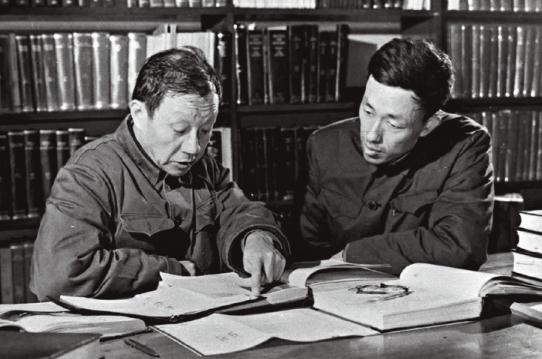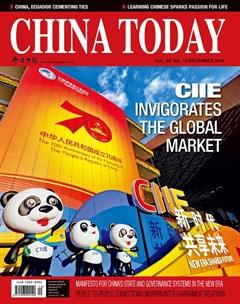Wang Daheng,Father of Chinese Optical Engineering
By staff reporter DANG XIAOFEI

BY the time of the founding of the Peoples Republic of China in 1949, the field of applied optical science was nonexistent in the country, as was the production of precision optical instruments as a result. Understanding its importance for national strength, the Chinese government paid much attention to optical research.
Wang Daheng, a renowned optical physicist, devoted his whole life to this cause. He oversaw the development of Chinas first optical glass, first electronic microscope, first laser device, and first largesize optical measuring equipment, and helped found the Chinese Academy of Engineering. He was therefore called the father of Chinese optical engineering.
Achieving Many Firsts in Chinas History
Wang Daheng was born in Japan in 1915. His father, Wang Yingwei, an astronomer and meteorologist from Jiangsu Province, worked at the observatory in Beijing and Qingdao after returning to China from Japan. When Wang Daheng was a teenager, he often followed his father to the observatory, and became greatly interested in the apparatus there. In 1936, he graduated from Tsinghua University with a degree in physics. Two years later he won a government scholarship to study in England. After earning his masters degree from Imperial College London in 1940, he began his doctoral studies at the University of Sheffield in optical physics and technology under the tutorship of William Ernest Stephen Turner (1881-1963), a British chemist and pioneer of scientific glass technology. Before finishing his doctoral studies, Wang learned of the vacuum in the field of optical glass in China, and decided to start his career in this field immediately. In order to learn the craft of producing this glass, Wang found a job at a British company.
In 1948, Wang gave up his established career and comfortable life in the West and returned to his motherland with the aim of empowering it through science and technology.
At the time China did not have the capability to produce optical measuring equipment on its own. In 1951, Wang was instructed to found an institute of fine mechanics, which opened in Changchun the following year. That was to be the predecessor of the Changchun Institute of Optics, Fine Mechanics and Physics under the Chinese Academy of Sciences. Wang was appointed its first president.
Within less than two years after the establishment of this institute, Wang and his team produced the first batch of China-made optical glass under primitive conditions, forever altering the situation that China was unable to manufacture such glass.
Over the following six years, Wang and his team went on to develop the countrys first electronic microscope, first high-precision theodolite, first optical range finder, and five other sophisticated optical devices, laying the foundation for Chinas precision optical instrument industry. In 1961, just 10 months after the invention of the ruby laser in the U.S., Wang and his team independently developed it in China.
In addition to scientific research, Wang advanced the study of optics in higher education. In 1958 he founded the Changchun Institute of Optics and Fine Mechanics (now Changchun University of Science and Technology) to cultivate optical researchers and engineers. He was both the president and a professor of this institute. Later he founded or co-founded other institutes of optics and precision mechanics in Xian,Shanghai, Hefei, and Chengdu as well as the Shanghai Institute of Technical Physics, laying a solid foundation for optics research in China.
Successful Application
Starting in the 1960s, Wang participated in optical research related to the development of nuclear bombs, missiles, and man-made satellites. Though optics only played a supportive role in this project, it is indispensable in relevant surveying, measuring, observation, recording, and communication.
When China successfully tested its first nuclear bomb, the iconic image of that historic moment was the billowing mushroom cloud. It was impossible for humans to take photos of this scene at a close range, as people were kept 60 kilometers from the detonation site to avoid being affected by the resulting nuclear shock wave and radiation. As a result, the job was done by a specially-made camera set up close to the explosion site, and that camera was developed by a team headed by Wang.
China successfully launched the Dongfanghong I satellite in 1970, of which Wang was the vice chief designer. The space missions demanded more sophisticated optical devices, including Earth observation cameras and high-resolution optical systems that could work over an extended period in an environment of extreme variations. Working day in and day out, Wang and his team accomplished the task according to schedule. When the satellite returned to Earth, the devices they designed brought back clear images of our home planet as seen from the outer space for the first time, to the Chinese people. Today, the optical theodolite Wang developed still plays an important role in Chinas Shenzhou spacecraft.
Other inventions of Wang are also of epoch-making significance for Chinas national defense, laser technologies, manufacturing of color televisions, and the sector of optical equipment. He is therefore called the Father of Chinese Optical Engineering. To honor his remarkable achievements and contributions, the International Astronomical Union named asteroid No. 17693 after him in 2010.
Closing the Gap with the World
In 1983, Wang left the Changchun Institute of Optics, Fine Mechanics and Physics, where he had worked for 30 years, and was transferred to the Chinese Academy of Sciences. From then on, he expanded the focus of his work to the development of the whole science and technology sector of China.
To close the technological gap between China and developed countries, Wang and three other scientists made the proposal to draw up a state hi-tech development plan in 1986, which led to the famous 863 Program. This program made hi-tech development a major strategic mission in Chinas technological modernization, and ushered the country into the global race in the hi-tech sector. Its implementation effectively uplifted Chinas technological standing in the world. In the following years, the country independently developed or made major breakthroughs in a number of key technologies, and reached or approached the highest level of advancement in the world. These advances created hundreds of billions of dollars worth of economic profits.
In 1992, Wang and a group of other scientists advocated for the creation of the Chinese Academy of Engineering. In the following years, he won even more honors from the state, including the State Science and Technology Advancement Award, the medal for heroes of Chinas first nuclear bomb, missile, and man-made satellite, and an award from the Ho Leung Ho Lee Foundation.
Wang was engaged in Chinas technological development and advancement cause throughout his life. In his last years, while he was bedridden, he continued to draft reports on optical terminology and wrote letters to state leaders to give proposals. He passed away in Beijing aged 96 on July 21, 2011 after living a full and fruitful life.

